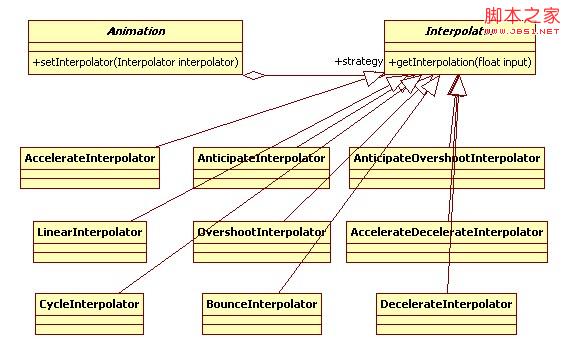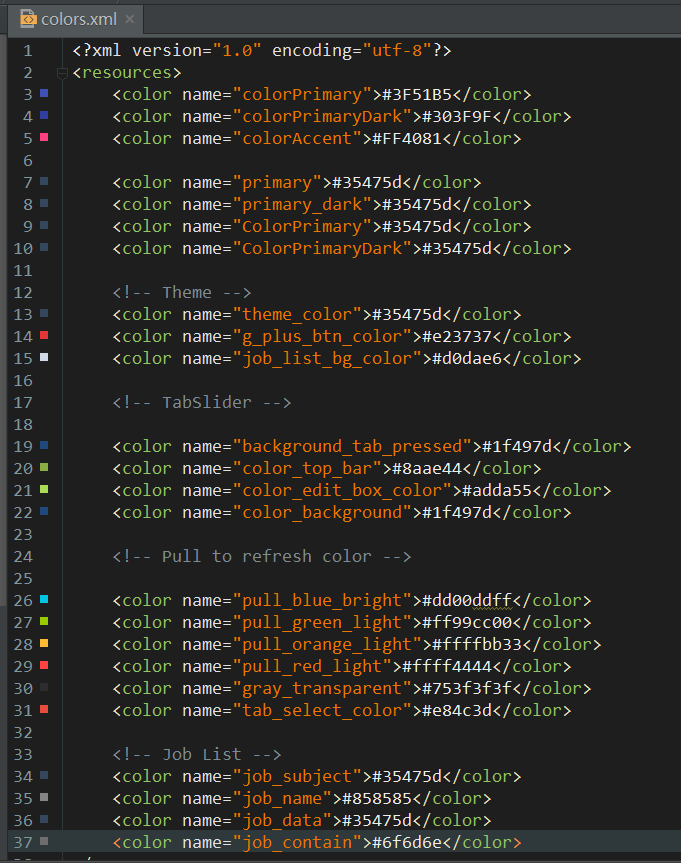編輯:Android開發實例
策略模式其實特別簡單(聽到這句話,大家是不是心裡一下子放松了?)。
比如排序,官方告訴大家我這裡有一個排序的接口ISort的sort()方法,然後民間各盡其能,實現這個排序的方法:冒泡,快速,堆等等。
這些方法就是“不同的策略”。
然後,某個模塊下,需要一個排序方法,但是暫時不能指定具體的sort方法(出於擴展的考慮),就需要使用ISort接口了。
最後,具體什麼場景下,傳入什麼具體的sort方法,實現靈活的排序。
這就是策略模式!
下面,我們分析Android中的動畫是如何使用策略模式的。
1. 意圖
定義一系列的算法,把它們一個個封裝起來,並且使它們可互相替換。
策略模式使得算法可獨立於使用它的客戶而變化。
2. 結構圖和代碼
Animation不同動畫的實現,主要是依靠Interpolator的不同實現而變。
定義接口Interpolator:
代碼如下:
package android.animation;
/**
* A time interpolator defines the rate of change of an animation. This allows animations
* to have non-linear motion, such as acceleration and deceleration.
*/
public interface Interpolator {
/**
* Maps a value representing the elapsed fraction of an animation to a value that represents
* the interpolated fraction. This interpolated value is then multiplied by the change in
* value of an animation to derive the animated value at the current elapsed animation time.
*
* @param input A value between 0 and 1.0 indicating our current point
* in the animation where 0 represents the start and 1.0 represents
* the end
* @return The interpolation value. This value can be more than 1.0 for
* interpolators which overshoot their targets, or less than 0 for
* interpolators that undershoot their targets.
*/
float getInterpolation(float input);
我們以AccelerateInterpolator為例,實現具體的策略,代碼如下:
代碼如下:
package android.view.animation;
import android.content.Context;
import android.content.res.TypedArray;
import android.util.AttributeSet;
/**
* An interpolator where the rate of change starts out slowly and
* and then accelerates.
*
*/
public class AccelerateInterpolator implements Interpolator {
private final float mFactor;
private final double mDoubleFactor;
public AccelerateInterpolator() {
mFactor = 1.0f;
mDoubleFactor = 2.0;
}
/**
* Constructor
*
* @param factor Degree to which the animation should be eased. Seting
* factor to 1.0f produces a y=x^2 parabola. Increasing factor above
* 1.0f exaggerates the ease-in effect (i.e., it starts even
* slower and ends evens faster)
*/
public AccelerateInterpolator(float factor) {
mFactor = factor;
mDoubleFactor = 2 * mFactor;
}
public AccelerateInterpolator(Context context, AttributeSet attrs) {
TypedArray a =
context.obtainStyledAttributes(attrs, com.android.internal.R.styleable.AccelerateInterpolator);
mFactor = a.getFloat(com.android.internal.R.styleable.AccelerateInterpolator_factor, 1.0f);
mDoubleFactor = 2 * mFactor;
a.recycle();
}
public float getInterpolation(float input) {
if (mFactor == 1.0f) {
return input * input;
} else {
return (float)Math.pow(input, mDoubleFactor);
}
}
}
其他的Interpolator實現在此不列舉了。
如何在Animation模塊實現不同的動畫呢?
在這裡我想提一個應用很廣的概念:依賴注入。
在Animation模塊裡實現不同的動畫,就是需要我們把各個Interpolator以父類或者接口的形式注入進去。
注入的方法一般是構造函數,set方法,注釋等等。
我們看看animation類是怎麼做的:
代碼如下:
public abstract class Animation implements Cloneable {
Interpolator mInterpolator;
// 通過set方法注入
public void setInterpolator(Interpolator i) {
mInterpolator = i;
}
public boolean getTransformation(long currentTime, Transformation outTransformation) {
// ... ...
// 具體調用
final float interpolatedTime = mInterpolator.getInterpolation(normalizedTime);
applyTransformation(interpolatedTime, outTransformation);
// ... ...
}
// 缺省實現,是個小技巧,順便提下,這個不是重點
protected void ensureInterpolator() {
if (mInterpolator == null) {
mInterpolator = new AccelerateDecelerateInterpolator();
}
}
}
策略模式其實就是多態的一個淋漓精致的體現。
3. 效果
(1).行為型模式
(2).消除了一些if...else...的條件語句
(3).客戶可以對實現進行選擇,但是客戶必須要了解這個不同策略的實現(這句話好像是廢話,總而言之,客戶需要學習成本)
(4).代碼注釋中提到了缺省實現,可以讓客戶不了解策略,也能實現默認的策略
(5).注入的方式有多種:構造函數,set方法,注釋。配置解析等等
 Android小人時鐘的開發實例分享
Android小人時鐘的開發實例分享
本文乃是一位Android開發愛好者為大家奉獻的一個小人時鐘的Android開
 淺析Android文件管理器(項目一)
淺析Android文件管理器(項目一)
文件管理器是管理文件的軟件,幫助用戶處理日常工作,管理儲存在本地和網絡中的文件。所有文件管理器都提供了基本的操作如創建、打開、查看、編輯、移動和刪除文件。許多An
 Android MediaPlayer(多媒體播放)
Android MediaPlayer(多媒體播放)
Android提供了許多方法來控制播放的音頻/視頻文件和流。其中該方法是通過一類稱為MediaPlayer。Android是提供MediaPlayer類訪問內置的媒體播放
 Android MediaPlayer(多媒體播放)
Android MediaPlayer(多媒體播放)
Android提供了許多方法來控制播放的音頻/視頻文件和流。其中該方法是通過一類稱為MediaPlayer。Android是提供MediaPlayer類訪問內置的媒體播放